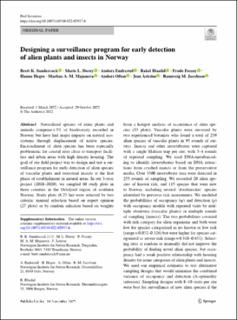Designing a surveillance program for early detection of alien plants and insects in Norway
Sandercock, Brett; Davey, Marie Louise; Endrestøl, Anders; Blaalid, Rakel; Fossøy, Frode; Hegre, Hanne; Majaneva, Markus; Often, Anders; Åström, Jens; Jacobsen, Rannveig Margrete
Peer reviewed, Journal article
Published version

Åpne
Permanent lenke
https://hdl.handle.net/11250/3033549Utgivelsesdato
2022Metadata
Vis full innførselSamlinger
- Publikasjoner fra CRIStin - NINA [2397]
- Scientific publications [1423]
Originalversjon
10.1007/s10530-022-02957-6Sammendrag
Naturalized species of alien plants and animals comprise < 3% of biodiversity recorded in Norway but have had major impacts on natural ecosystems through displacement of native species. Encroachment of alien species has been especially problematic for coastal sites close to transport facilities and urban areas with high density housing. The goal of our field project was to design and test a surveillance program for early detection of alien species of vascular plants and terrestrial insects at the first phase of establishment in natural areas. In our 3-year project (2018–2020), we sampled 60 study plots in three counties in the Oslofjord region of southern Norway. Study plots (6.25 ha) were selected by two criteria: manual selection based on expert opinion (27 plots) or by random selection based on weights from a hotspot analysis of occurrence of alien species (33 plots). Vascular plants were surveyed by two experienced botanists who found a total of 239 alien species of vascular plants in 95 rounds of surveys. Insects and other invertebrates were captured with a single Malaise trap per site, with 3–4 rounds of repeated sampling. We used DNA-metabarcoding to identify invertebrates based on DNA extractions from crushed insects or from the preservative media. Over 3500 invertebrate taxa were detected in 255 rounds of sampling. We recorded 20 alien species of known risk, and 115 species that were new to Norway, including several ‘doorknocker’ species identified by previous risk assessments. We modeled the probabilities of occupancy (ψ) and detection (p) with occupancy models with repeated visits by multiple observers (vascular plants) or multiple rounds of sampling (insects). The two probabilities covaried with risk category for alien organisms and both were low for species categorized as no known or low risk (range = 0.052–0.326) but were higher for species categorized as severe risk (range = 0.318–0.651)... Arthropods · DNA-metabarcoding · Early detection · Invasive · Invertebrates · Occupancy models · Rapid response · Study design · Vascular plants Designing a surveillance program for early detection of alien plants and insects in Norway
